X-NUMX mm A-122 gun: unparalleled
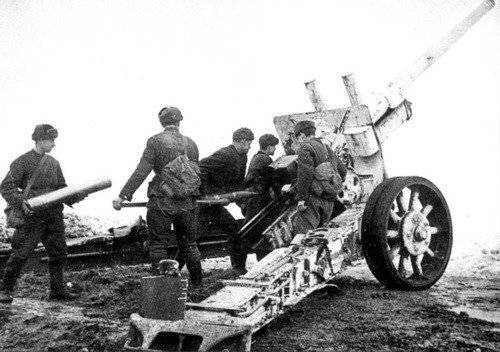
First of all, it is worth saying a little about the caliber. The caliber in 122 millimeter, more precisely 121,92 mm (4,8 inch) is a purely Russian invention and until a certain time has not been used anywhere except our artillery. This caliber appeared more than a hundred years ago, when the gunners of the Russian Empire needed a new class of howitzers with better characteristics than the existing ones. On the basis of combat indicators, mobility and production complexity, the very same 4,8 inches were selected, which remained in the nomenclature of weapons over the next decades.
The history of the A-19 cannon goes back to the mid-twenties of the last century. At that time, two ideas coexisted in the minds of the military leaders responsible for the artillery. Firstly, during the Civil War, French-made 120-mm cannons demonstrated their good potential. Secondly, a new cannon for corps artillery was required - the existing 107-mm guns of the 1910 model of the year were already outdated, and modernization could not have the expected effect. The result of the analysis and reflection was the task of the Artillery Committee to create an 122-mm gun for corps artillery. At the beginning of 1927, the development of the gun was entrusted to the Design Bureau of the Committee. The chief designer was appointed F.F. Lender, who led the project until his death in September of the same year. By the middle of 29, a draft 122-mm corps gun was prepared, after which the design bureau of the Artillery Trust was assigned to it.
In accordance with the latest "trends" of the gun case of the time, A-19 received a carriage with a sprung wheel drive and two sliding beds. The wheels of the mast had their own leaf springs. Their blocking before shooting was done manually. The wheels had a metal construction and cast rubber tires. Immediately above the axis of the wheel travel, a shield was installed to protect the calculation from bullets and fragments. The barrel of the gun consisted of three main parts: a pipe, a barrel casing and a screw breech. The piston bolt design of the gun was borrowed from the 152-mm howitzer of the 1910 / 30 model of the year and adjusted for the new caliber. The gun was attached to the carriage through the recoil device. At the same time, the recoil brake was hydraulic, and the thumb wheel was hydropneumatic. All units recoil device installed in the cradle of the gun, under its barrel. A lifting and balancing mechanism (made on the basis of springs) allowed vertical guidance in the range from -2 ° to + 45 °. The screw turning mechanism, in turn, provided guidance in a horizontal plane within a sector of width 56 °.
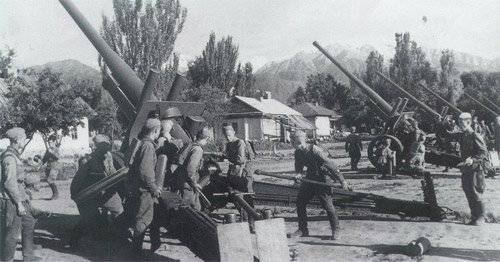
Simultaneously with the transfer of work on the instrument, the Perm Plant No. XXUMX ordered the designation of the Weapon Arsenal Trust Design Bureau to order to build a prototype gun. In October, the 172 of the year, two new guns were brought to the landfill, differing in the nuances of the barrel design. In addition, at this stage of development, the new cannon had a muzzle brake. A few months after the start of the tests, the documentation for their conduct, along with the drawings and calculations, the guns were transferred to Plant No. XXUMX, which was entrusted with the final refinement and preparation for mass production. It was at this enterprise that the gun received the index A-1931. A few months later, in the middle of 38, the Barricades Stalingrad plant received an order for an experimental batch of three A-19 cannons. From November 33, this party was tested at the Luga proving ground, after which the cannon was recommended for adoption. 19 March 35, the official document was issued, according to which the "13-mm corps gun model 1936 of the year" was adopted by the Red Army.
Starting from 35, the A-19 cannons were in mass production at the Barricades. The assembly of the guns continued until the 1939 year, when the updated A-19 version began to crowd them out. Because of this, and some features of the production documentation, it is impossible to establish the exact number of tools produced. The most likely number is 450-500 instances.
The first months of operation of the new cannons in the army generally confirmed the findings of the test committee. At the same time, the military complained of some flaws. If the problems with the tool itself were mainly related to the nature of the production, then the carriage had several design flaws. First of all, claims were made to the design of the wheel course. Outdated wheels with metal spokes and a rim and a rubber tire did not provide the gun with adequate mobility. In addition, when calculating a weapon from a traveling position to a combat one and back, it was necessary to spend time and energy on blocking the springs - this had to happen automatically. The gun carriage of the corps gun was not without any complaints from the manufacturers. Factory workers "Barricades" complained about the complexity of its manufacture. It required a serious refining of the carriage. Fortunately, in the 1936, testing began on the new 152-mm howitzer ML-20. Among other things, she had a new carriage of the original design that fully met the requirements of the military. The latter initiated the beginning of work on the adaptation of the gun A-19 to the installation on the ML-20 carriage. This proposal had a whole bunch of positive effects. First of all, the gun howitzer ML-20 greatly facilitated the work with the tool and maintenance. In addition, the creation of a so-called. duplex (two different tools with a single carriage) could significantly reduce the cost of manufacturing both tools due to the lack of need to assemble various units.
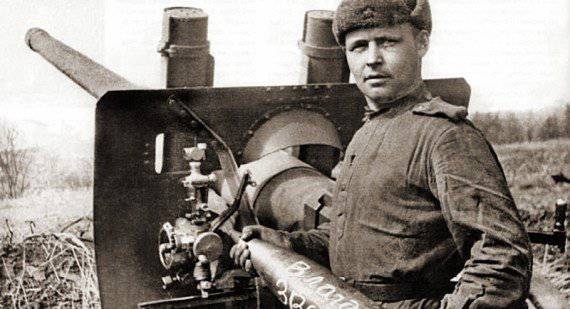
The modernization of the A-19 gun for installation on the new carriage was entrusted to engineers of the Perm Plant No. XXUMX, and FF was appointed the chief designer. Petrova. Adaptation of the gun carriage and the guns to each other did not take much time - we had to wait longer for the finishing of the ML-172 and its gun carriage. As a result, in September 20, the updated A-1938 (the former index used by the designers remained unchanged) was sent for testing. All the problems and defects identified in the tests were soon corrected and on April 19 of 29 a new document was released. At this time, the leadership of the Red Army adopted the "39-mm corps gun model 122 / 1931's."
Unlike the original A-19, the updated gun was made not only at the factory "Barricades". At the end of the 39, the first copies of the gun arr. 1931 / 37 were collected at Stalingrad. It was these tools that led to confusion in statistics and the inability to accurately determine the number of A-19 31 samples produced by the year. The barricades produced a cannon until 1941, after which the production was transferred to Perm. In addition, in 41, A-19 cannons were made in Novocherkassk, at plant No. 352. The production of A-19 in the 37 version of the year went before 1946. For seven years, was made about two and a half thousand guns. The total number of A-19 of both versions is equal to 2926 units. This number does not include those versions of the gun, which were intended for installation on self-propelled artillery installations.
Due to the large caliber, the gun A-19 had a separate-shell loading. At the same time, to ensure effective destruction of targets in a wide range of distances, sleeves were made in four versions. In a metal cup 785 millimeters long, there could be a full charge or three (No. 1, No. 2, No. 3) charges of lesser power. The maximum charge of gunpowder weighed 6,82 kilograms. The armament A-19 included 122-mm high-explosive fragmentation, caliber armor-piercing, concrete-piercing and chemical shells. In total, there were 11 specific types. Separately, it is worth noting that the calculations of the A-19 guns were forbidden to fire with howitzer shells of a suitable caliber, using a fully loaded cartridge case. In addition, the use of certain types of howitzer ammunition was completely prohibited. The fact is that due to other loads on the projectile in the barrel of the howitzer, the ammunition can be made less durable than that required for use in guns. Therefore, the main ammunition issued to the calculations was the high-explosive fragmentation family OF-471. During the Great Patriotic War, gunners repeatedly had to shoot high-explosive shells at tanks the enemy. In this case, the armor penetration was noticeably less than when using specialized armor-piercing shells, but in the absence of the latter, in the first months of the war, the OF-471 or OF-471V ammunition was quite suitable for the destruction of most German tanks. An armor-piercing projectile BR-471B (caliber blunt-headed) at a distance of a kilometer at a 90 ° angle of penetration pierced 145 millimeters of armor. The BR-471 sharp-headed caliber projectile under the same conditions pierced a 130-mm plate.
On the basis of the A-19 gun of the 31 model, not only the gun mod. 37 d. In the middle of the Great Patriotic War, this design served as the basis for a new weapon:
- A-19C. At the end of 1943, the production of ISU-152 self-propelled guns with the ML-20 gun was launched. Then the idea to install on a similar chassis and gun A-19. In December of the same year, a prototype was assembled under the title “242 Object”. To adapt the towed gun to use in the ACS, it was necessary to transfer all controls to one side, install a receiving tray in front of the chamber to improve the usability of the loader and equip the gun with an electric trigger. 12 March 1944, this self-propelled gun was put into service under the name of ISU-122. Just two months after adopting the self-propelled gun, the A-19C gun was modernized, the purpose of which was to improve the characteristics of the barrel. After these works, the barrels of the “old” and “new” guns ceased to be interchangeable. In official documents, the A-19C was designated as "122-mm self-propelled gun of the 1931 / 44 model."
- D-2 and M-5. Also in 1943, an attempt was made to create a specialized anti-tank gun with A-19 ballistics. According to reports, the D-2 was a lightweight A-19 on a carriage of the M-30 howitzer. M-5, in turn, was a significant upgrade of A-19 on the same carriage. The guns were tested in the middle of the 43 and the beginning of the 44, respectively. Both test shooting cycles did not reveal any positive aspects of the new guns. Moreover, when testing M-5, the muzzle brake broke twice. None of these guns was adopted.
- D-25. In 1943, the year J.A. Kotin proposed to develop a tank variant A-19 for installation on heavy armored vehicles. The design office of the plant number 9 for several months has coped with this work. The light-weight A-19 stem group (similar to this gun assembly) was mounted on the X-NUMX-mm D-85 tank gun cradle. In addition, solutions applied on the A-5C were introduced into the D-25 design. Finally, the gun was equipped with a muzzle brake. In December of the same year, the resulting “19-mm tank gun of the 122 model of the year (D-1943T)” was installed on the EC-25 tanks. The guns of the D-2 family were installed on several Soviet heavy tanks, including the T-25.
Initially, the A-19 guns were attached to corps artillery. As of 1940-41, the corps artillery regiments were divided into three types. As part of the first, there were two battalions of the ML-20 howitzers and one A-19 division (12 cannons) or 107-mm cannons. In the second, there were two divisions each: ML-20 and A-19. The latter in this case there were 24 units per regiment. In the regiments of the third type, all three divisions were armed with howitzers ML-20. After the abolition of corps artillery and its subsequent restoration, each regiment was equipped with 16-20 guns of various types. In addition, X-NUMX A-48 units at the beginning of the war were part of the artillery reserve of the High Command.
For the first time, A-19 took part in real combat operations during the events on the Khalkhin-Gol river. The exact type of these guns is unknown, as well as the exact number. Losses guns did not have. A-19 in the 37 version of the year went to the front during the war with Finland. Of the 127 guns, three were lost. The experience of using guns fully confirmed the need for such weapons, although in some cases 122-mm guns represented excessive force.
Of the 1300 guns that were available to the troops at the time of the start of World War II over the 41 years, about nine hundred were lost. In this case, most of the losses occurred in the A-19 version of the 31 year. The remaining guns, with some casualties, participated in the battles until the end of the war. German clusters of equipment and manpower, columns on the march, important stationary objects, etc. were subjected to shelling from А-19. If necessary, as it was during the Battle of Kursk, A-19 could fire direct fire on enemy tanks. However, in this case, good armor penetration was compensated by the large size of the weapon and low speeds of movement of the barrel.
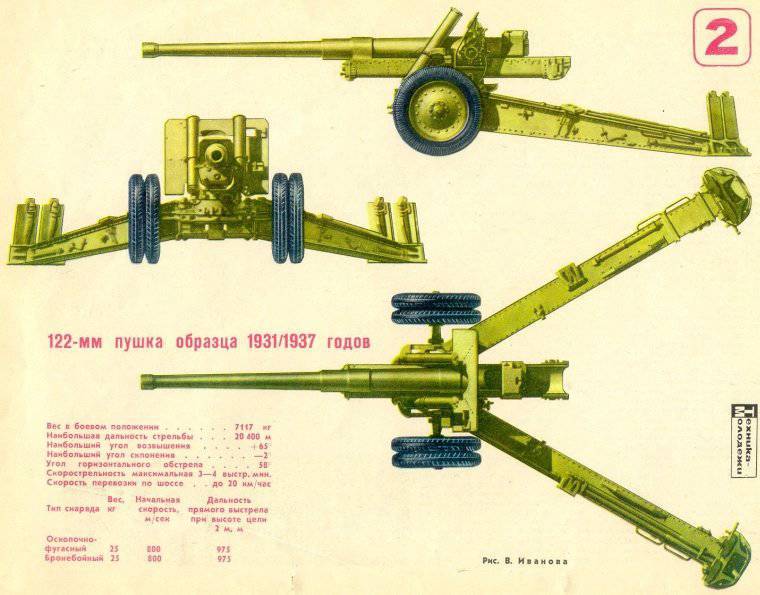
A number of A-19 guns fell into the hands of Germans and Finns. The Wehrmacht received at least 420 guns as trophies, which were used under the name 12,2 cm Kanone 390 / 1 (r). 25 guns went to Finland, where they were renamed 122 K / 31. Both opponents of the Soviet Union actively used guns, although the Finns soon had to send them to serve in the coastal defense. The fact is that this country began to experience a shortage of heavy artillery tractors and 122 K / 31 turned out to be “attached” only to coastal artillery. It is noteworthy that in the warehouses of Finland there is still a number of trophy A-19. Since the war, they went through several upgrades, during which the gun carriages and guns were updated.
In general, the project A-19 can be considered successful. “Children's diseases” in the form of flaws in the early construction of the mast were corrected over time, and they could not proceed to the tank version and self-propelled gun version by definition. Separate attention is the applied charging system. Four variants of powder charge in combination with the maximum angle of elevation in 45 ° actually make А-19 not just a gun, but a gun-howitzer. As for comparing guns with foreign analogues, this is a difficult and ungrateful business. The fact is that other participants in the Second World War simply did not have 122 caliber guns of a millimeter. So, in German field artillery, the closest in caliber to the A-19 were 10,5 cm Kanone 18 and 15 cm Kanone 18. Similarly, the situation with the artillery of other countries. As a result, a full-fledged comparison of the A-19 with foreign guns is impossible: foreign guns of a smaller caliber are significantly losing to the Soviet one in terms of firing range and other parameters, and the larger ones have a better range, but are heavier and less mobile. Nevertheless, the results of the use of А-19 cannons on the margins of the Great Patriotic War fully confirm the pre-war opinion that this class of artillery is necessary.
On the materials of the sites:
http://armor.kiev.ua/
http://soldat.ru/
http://battlefield.ru/
http://kursk1943.mil.ru/
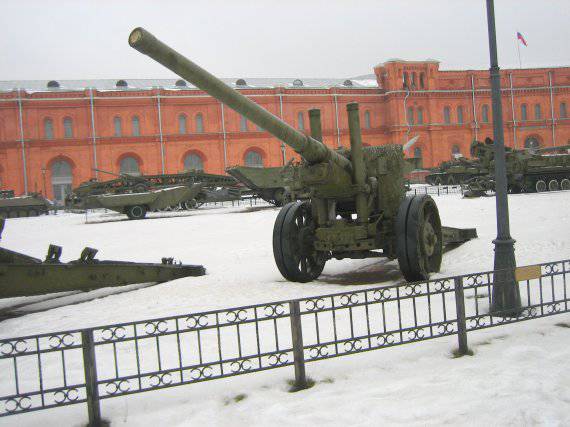
Information